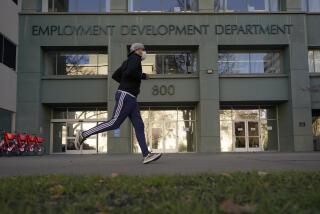Don’t tap into TARP for jobs program
- Share via
Eager to put more unemployed Americans to work, the Obama administration and congressional Democrats want to tap into an unexpected source of cash: billions of dollars in emergency loans that once-troubled banks are now repaying. The Troubled Asset Relief Program doled out more than $200 billion to the likes of Citigroup, Bank of America and JPMorgan Chase to avoid devastating bank failures and ease the credit crunch. Half of the money has been paid back, and over time the Treasury Department actually expects to turn a profit on the investments, Treasury Secretary Timothy F. Geithner told Congress this week. Not every TARP loan is expected to be repaid -- remember, billions went to U.S. automakers and American International Group -- but Geithner said the ultimate cost of the program is likely to be a mere $34 billion, or $200 billion less than anticipated. Now, President Obama and top Democrats are calling on lawmakers to use some of that $200 billion for another stimulus package, one focused more sharply on creating jobs.
Obama’s speech Tuesday came days after the government released the most hopeful news yet about the economy: only 11,000 jobs lost in November, the lowest total by far since the recession started in December 2007. Nevertheless, as this week’s UCLA Anderson Forecast indicates, the recession’s effects will linger long after its official end. Sluggish growth is likely to keep unemployment stubbornly high for three years or more -- unless some way is found to create jobs more quickly, which would boost growth and speed the return to full employment.
The administration has proposed a hodgepodge of efforts to create jobs and prevent layoffs, including some targeted tax cuts, more transportation projects and additional grants to struggling states and cities. Some of these ideas, such as the tax cuts to lower the cost of capital, are compelling. Some, such as a temporary tax cut to encourage small businesses to create jobs, rehash ineffective efforts from previous recessions. And much of the proposal simply expands on what Washington already did in the $787-billion stimulus package that passed in February.
Before we do any of this, the administration should explain why the massive amount of money already approved to stimulate the economy isn’t sufficient. After all, most of it hasn’t been spent; according to the administration’s Recovery.gov website, only 20% of the $787 billion had been handed out as of Oct. 30. And if more funds really are necessary, the administration should find a way to raise them without exacerbating the federal deficit, which hit $1.4 trillion in the fiscal year that ended Oct. 31.
The idea of converting bank bailout funds into jobs programs might have populist appeal, but the returned TARP dollars aren’t new revenue. They’re borrowed money, and we should be thankful we can pay so much of it back.
More to Read
Get the L.A. Times Politics newsletter
Deeply reported insights into legislation, politics and policy from Sacramento, Washington and beyond. In your inbox twice per week.
You may occasionally receive promotional content from the Los Angeles Times.










